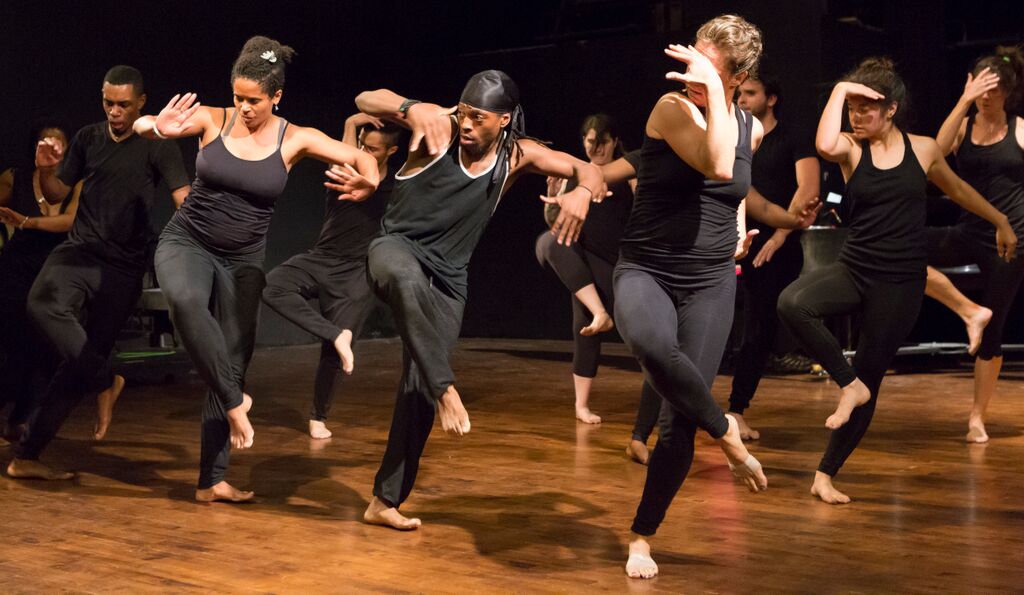The inevitable end of summer has given us some perfect evenings for a picnic and a show in downtown Chicago. Indeed, the lawn at Pritzker Pavilion in Millennium Park was packed last Thursday for a unique collaboration made possible by the two heads of state of a venue previously known as the Viaduct Theatre. Links Hall’s Roell Schmidt and Constellation’s Mike Reed joined forces to produce The Black Saint and the Sinner Lady, inspired by Charles Mingus’ score of the same name with composer/music director Greg Ward and choreographer Onye Ozuzu at the helm. The work was part of a larger series called Made in Chicago, a weekly free concert series devised through curatorial partnerships with local jazz artists and presented by the Department of Cultural Affairs and Special Events with the Jazz Institute of Chicago.

The evening began with a shorter performance by an emerging jazz ensemble, followed by a kind of weird, awkward pledge drive for the Jazz Institute of Chicago, followed by a weird, awkward pause as the stage was changed over. But once Greg Ward’s ensemble took the stage, it was smooth sailing.
The choreography began in silence, with a large, eclectic group of dancers slithering across the stage from (stage)left to right in an apparently improvised pass. Ozuzu emerged from the mess of arms and legs, to arrange herself stoically on a stool beside the band as the dancers, mostly in three groups at the front of the stage, embodied the Mingus score as reimagined by Ward.
Each of the nine songs in the musical score ran together back-to-back. Six were danced by various combinations of the cast; the three unaccompanied songs were played while dancers draped their bodies across the risers and took water. There was a casual feel to the evening, as though this was a jam session at a seedy, underground night club and not a sophisticated concert hall production with thousands in the audience. Each dance seemed loosely composed, with unison sections nestled beside structured improvisations.

The anchor of Ozuzu’s creations was a clear commitment to representing multiple genres of dance, including ballet, modern, jazz, and African. Stylistic diversity was mirrored in the cast, which included notables such as contemporary ballet dancer Paige Cunningham Caldarella and Hedwig Dances’ Edson Cabrera, plus a few fantastic break dancers, and a gaggle of students and alum from the Dance Center of Columbia College Chicago.
As the new interim Dean of Arts and Sciences at Columbia College Chicago, it is a complete mystery as to how Onye Ozuzu has any creative energy left (let alone energy in the general sense) to devote to such a big project, and yet there was something quite magical about how she combined Western and non-Western dance forms to create her collage. Better still was her breathtaking solo in the final movement, when Ozuzu came down from her perch and gave us a truly special moment in which dance and music became one.
Was the dancing in perfect unison? No. Were the all-black costumes and the jumbo-tron view from the lawn conducive to watching dance? Not really. But that’s not the point. Perhaps a bit tighter unisons and some bright white costumes would have helped the viewer’s experience a little, and to be honest, if not for the gorgeous weather I might rather have watched Black Saint and the Sinner Lady in a more intimate venue, such as, I don’t know… Constellation.
More importantly, though, the goal of this program was to expose people to dance, and music, and to what happens when dancers and musicians work together to make something beautiful.
And so it did.
—
Made in Chicago: World Class Jazz continues through August 27. Concerts take place on Thursday evenings beginning at 6:30pm at the Jay Pritzker Pavillion in Millennium Park, and are free to the public!
